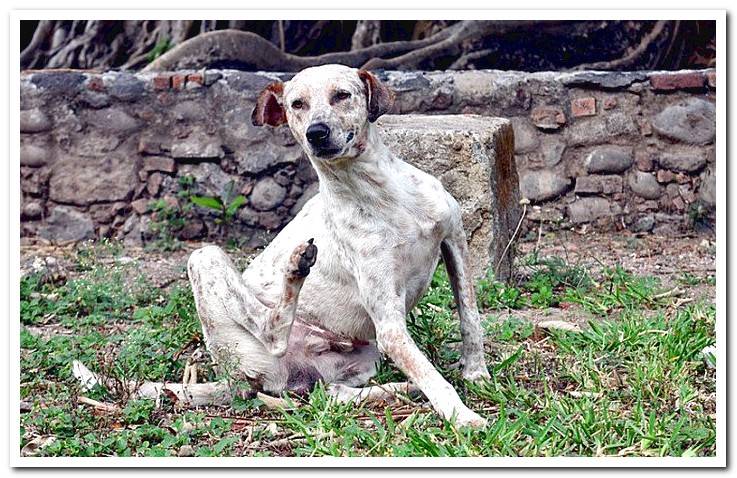
Fleas are very frequent parasites in dogs of any age. Able to infest them at almost any time of the year, we must know the measures to prevent their attack and spread.
These insects are not only an aesthetic nuisance, as they can transmit other parasites such as tapeworms or cause health problems such as anemia or allergic dermatitis to their sting, which we will talk about below.
- You may also like: Fleas at home How to eliminate them?
Index of contents
- 1 What is the DAPP?
- 2 Symptoms of DAPP
- 3 How is DAPP diagnosed?
- 4 How do I know if my dog has fleas?
- 5 Is DAPP Cured?
- 6 Why are fleas dangerous for the dog?
- 7 Remedies to avoid DAPP
What is the DAPP?
Flea bite allergic dermatitis is the most common allergy in dogs. Like all allergies, it occurs when the immune system reacts disproportionately against a stimulus that, in principle, would not be dangerous. In this case, the hypersensitivity reaction occurs against substances present in the fleas’ saliva.
In addition, we must know that the reaction can appear at the same time that the sting occurs or persist time after it. This explains why the dog shows injuries even if we do not find any trace of fleas. A single sting is enough to trigger the reaction.
Symptoms of DAPP
As it is a reaction caused by fleas, we could think that it is limited to the period of greatest presence of parasites. However, the home environments manage to maintain optimal living conditions for these insects, so that we can find them in any month of the year.
The clinical picture is characterized by the following signs:
- Intense itching, the dog will nibble on the affected areas.
- Hair loss due to scratching.
- Inflammation of the skin
- Red bumps that look like granites.
- The lesions appear on the rump, the base of the tail, the inguinal area and the abdomen, which are the areas with the highest concentration of fleas.
- In more serious cases we will see raw wounds, with their subsequent scabs. In addition, they can become infected.
- Over time, the skin thickens and darkens.

How is DAPP diagnosed?
In general, the diagnosis of this allergy is reached by the symptoms and the direct visualization of the fleas or their remains on the animal or its environment. If we cannot locate the insects, the clinical picture is usually enough for the vet to suspect DAPP.
In this case we will be prescribed a treatment. If it works, we will confirm the diagnosis. Otherwise, the vet will continue to search for the cause, since the symptoms of DAPP could be confused with other dermatological disorders.
How do I know if my dog has fleas?
The main indicator of the presence of fleas is scratching. If we check between the dog’s hair it is possible that we can see these flattened insects, of small size and black or reddish color. Its remains are appreciated as a black grit. It is the digested blood. Even without seeing them, any intense scratching suggests their presence.
- More information in: How do you know if a dog has fleas?

Is DAPP Cured?
The flea allergy is not eliminated but, if the dog does not come into contact with these parasites, it will not present symptoms. Therefore, preventive antiparasitic treatment it is the most effective remedy. This should also be applied to the environment, throughout the year and to all the animals in the house.
The lesions caused by this allergy may need treatment with antihistamines or corticosteroids to relieve itching, in addition to topical or oral antibiotics in cases that have been complicated by bacterial infection.
Why are fleas dangerous for the dog?
Fleas are not a minor problem. Firstly, due to its difficult eradication as it is found mainly in the environment, but also due to the consequences of an infestation for the animal’s health. In addition to the itching from the bites, we highlight the following:
- Contagion of other parasites: fleas can transmit to the dog the tapeworm, a intestinal parasite.
- Anemia: It occurs in severe infestations and weakened animals because fleas feed on blood. In puppies or small adults, anemia can be fatal.
- DAPP of which we have already spoken.
Remedies to avoid DAPP
Preventing fleas from coming into contact with the dog will be our priority objective. To achieve this, we must understand that fleas that are located on the dog must be eliminated, but also those located in the environment, which will also be approximately 95% of the total.
Thus, in addition to applying dewormers to all the animals in the house and eliminating adult fleas, we must take care of cleaning the environment and preventing the development of eggs. We will follow the following instructions, always using products prescribed by the vet:
- Put deworming products on all the animals in the house throughout the year.
- Dewormers must have a preventive effect, that is, protect the dog for weeks and it is recommended that they inhibit the growth of eggs, essential to eliminate the parasite load from the environment.
- Scrupulously follow the veterinaryn’s recommendations when administering dewormers to ensure their effectiveness. Of course, none will be 100% effective.
- It is convenient to use a comb to remove all the fleas by hand that we can.
- Wash the beds in the washing machine.
- Vacuum the house thoroughly and immediately dispose of the bag, if applicable.
- Clean with flea products paying special attention to cracks and crevices. Steam cleaning is very effective.
- In serious infestations we can resort to the so-called pumps that eliminate the crouching fleas in the environment.
